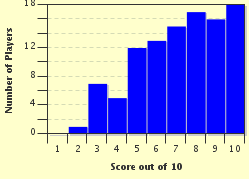Quiz Answer Key and Fun Facts
1. The most famous duel in American history involves the events of July 11, 1804 when the sitting US Vice President Aaron Burr shot and killed former Treasury Secretary Alexander Hamilton. What was the cause of the fight between the two men?
2. Not all duels are fought with guns. In 1592, when the Siamese King Naresuan met the Crown Prince of Burma in single combat to end a long war between the two nations, what "battle" animals were used?
3. Who knew that being a writer was so dangerous? What Russian poet and playwright famous for "Eugene Onegin" died in a duel with his brother-in-law in 1837?
4. A duel in mid 16th century Naples between Isabella de Carazzi and Diambra de Pettinella was immortalized by the Spanish painter by Jose de Riberta's in his 1636 work "Duelo de Mujeres". What was unique of this duel that merited de Riberta's attention?
5. Just because you are friends with a great artist does not mean you can get away with criticizing his art in public. What 19th century French Impressionist took time away from creating such classics works as "Music in the Tuileries" and "The Railway" to engage in an 1870 duel with Louis Edmond Duranty?
6. Apparently even in a country famous for not taking sides there are cases of conflict resolution requiring pistols to the death. In what European country, renowned for its neutrality, did early German Socialist leader Ferdinand Lassalle lose his life in a duel in August 1864?
7. No sitting US President has engaged in a duel. However, there is ample evidence that prior to becoming President this 19th century Tennesseean was an ardent duelist. In 1806, what future US President shot and killed Charles Dickinson in a duel?
8. Gaston Defferre and René Ribière were both members of the French National Assembly and participated in the last 'publicly acknowledged' duel in France. Charles de Gaulle was the President of France, and Georges Pompidou was the Prime Minister. During what turbulent decade did this "point d'honneur" take place?
9. When viewed retrospectively history is a fragile construct, where postulating a slight change in the outcome of minor events could radically alter the future. Imagine how the 20th Century would have differed had Rome newspaper editor Francisco Ciccotti prevailed in his 1921 duel with a rival journalist. Who is the Italian journalist that survived this contest to become Italy's "Il Duce"?
10. Perhaps the most bizarre duel occurred in France in 1808. Two Frenchman fought for the favor of a prominent Parisian ballerina. The men took their pistols and went skyward conducting their fight from the air suspended above the city by what unique method?
Source: Author
adam36
This quiz was reviewed by FunTrivia editor
bloomsby before going online.
Any errors found in FunTrivia content are routinely corrected through our feedback system.

